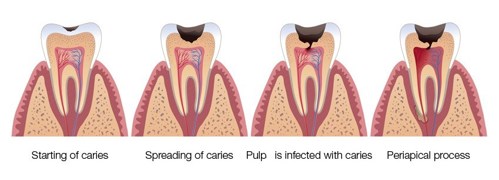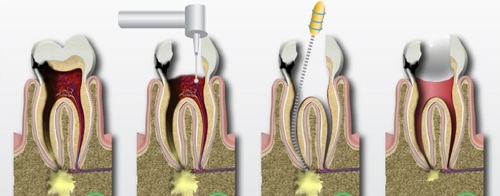Root Canal Therapy (RCT): Who needs it? What is the procedure and how can we avoid it?

By Dr. Ali Mohammadi B.D.S.
Most people have experienced or at least witnessed someone experiencing severe dental pain that cannot be easily settled sometimes even with pain killers. There are two probable sources for this pain: dental pulp or periodontium (dental supporting structures that keep teeth in place). If the pulp disease remains untreated, it can spread to the supporting tissues as well, eventually leading to an abscess.
Pulp tissue sits in the core of the tooth (pulp chamber and root canals). It consists of nerves, blood vessels, and connective tissue. Pulp tissue can become inflamed for various reasons. The most common reason is dental caries. The bacteria that live on teeth and in cavities produce materials that can be toxic to the pulp. They also can invade the pulp tissue when cavity becomes big enough to touch the pulp chamber. Inflammation is a defensive response against these irritants, however at the same time, responsible for the pain. When this condition remains untreated, the pulp tissue can die (necrosis). At this point, byproducts of necrosis along with bacteria exit the foramen at the end of root canal(s) and spread beyond the apex of the root into the periodontium. Now, this tissue is inflamed and risk of abscess formation is extremely high and can be life-threatening.

Trauma is another cause of pulp inflammation that can result in pulp necrosis in a longer process. These cases can be revealed several years after trauma and the first sign may be change in the colour of the tooth. These cases are treated with RCT plus internal bleaching[1].
There are some cases that a tooth needs RCT in spite of the fact that it is not painful. These circumstances happen usually with trauma cases or very big cavities that let the infection drain out of the pulp chamber. However, these teeth may become painful after a prolonged period of time if an obstruction happens in the drainage path or inflammation passes beyond the apex.
Once the inflammation in pulp tissue reaches a certain level, the tissue cannot reverse it and cannot heal. Hence, this condition should be treated with either Root Canal Therapy or Extraction of the tooth to prevent consequences of infection. The purpose of either treatment is to remove the inflamed, infected or necrotic pulp tissue.
The procedure:
As explained before, pulp tissue is located in the center of the tooth in pulp chamber and root canal(s) and the aim of RCT is to remove it.
Treatment starts with giving anaesthesia (numbness). First step is to provide an undisturbed access to pulp chamber and root canals while preserving tooth structure using dental burs.
Once the access is established, the second step is complete removal of pulp tissue from the chamber and canals. This task is carried out by mechanical measures and chemical agents. The aim is removal of infected/inflamed pulp tissue, disinfect the whole space and shape canals so that they can receive filling material specified for root canals.
The third and last step in RCT procedure is filling the space previously occupied by pulp tissue. Gutta-percha is a bio-compatible material derived from a tree with the same name that is used for this purpose and has replaced almost all previous root canal filling materials due to its superior qualities.
Depending on the condition of the pulp tissue, all these steps may be done in one, two or three appointment(s).
The next step in treatment is restoring the lost structure of the coronal part (top part) of the tooth which could be a filling or a crown (cap) depending on the amount and strength of the remaining structure.

Possible complications:
Not all RCT treatments are successful; the success rate is between 85% and 97%. So if a RCT treatment fails, which happens rarely, it should be redone or sometimes the problem should be fixed surgically (apicoectomy).
Post-op pain and discomfort:this is manageable using anti-inflammatory drugs.
Procedural problems like root perforation: there are other procedures to fix them.
Tooth colour change which can be fixed by internal bleaching.
Avoiding RCT:
The best way to avoid RCT is maintaining a very good oral health by following a standard oral hygiene routine and having regular 6 – 12 month dental checkups. During these checkups, small asymptomatic cavities could be found and fixed with a simple filling before bacteria harm pulp tissue.
Dr. Ali Mohammadi D.D.S. is from our 1300SMILES Townsville City practice andperforms all aspects of general dentistry with experience in pain-free treatments and root canal therapy with the maximum success rate. He has a special interest in restoring heavily destructed teeth with composite restoration and crowns.